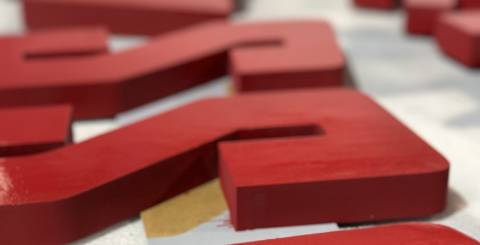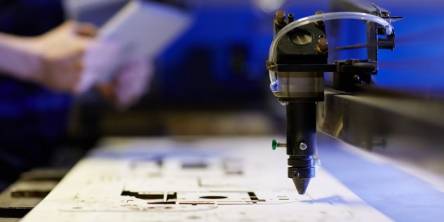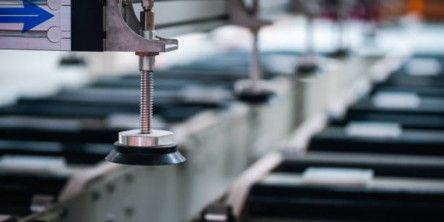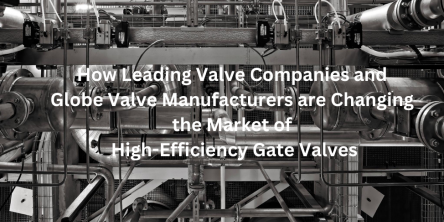The Advantage of Using Sintra Material to Fabricate Indoor and Outdoor Signage

Sintra is basically a PVC (Polyvinyl Chloride) - Expended closed cell foam core material, simply a sheet of vinyl. It is lightweight yet rigid, versatile and durable board.
We will try to explain the pros and cons of Sintra for indoor and outdoor uses when fabricating signs, logos, and letters.
So, how does Sintra material enhance decor for indoor and outdoor spaces?
Material Characteristics:
Sintra boards (sometimes called Sentra plastic sheets) come in many colors with a low gloss smooth matte finish on both sides, ranging from 1/4" to 1" in thickness.
For anything thicker than 1", layers can be glued together using a PVC glue that cures fairly fast. This material is typically used for 2D shapes and has a very smooth surface finish, so it does not require any post finish, such as patching or sanding.
It is denser than Styrofoam and as such, it is easily machined on a CNC router and does not require any special tools for let's say making holes in it, as opposed to acrylics.
Here are some of its characteristics:
Highly durable - Can withstand extreme weather conditions, resistant to moisture, UV rays and to impact
Lightweight - Therefore easy to handle, install and store
Versatile - Can be cut, shaped, formed to fabricate custom products and designs
Somewhat Affordable.
Outdoor and Indoor Use:
Sintra, very much like Styrofoam (Styrene) is great for both indoor and outdoor use, for signage, displays, letters, logos, exhibits and any graphic application.
It can withstand extreme high and low temperatures and will not be corroded or damaged by the sun like for example a Styrofoam material. It is resistant to dents, cuts & scrapes, allowing to leave it outside under the sun for a prolong period of time while still maintaining a new polished appearance.
It is also resistant to moisture and chemicals and therefore it is durable and a long-lasting material.
Can it Be Combined with Other Materials?
While we can print directly on the Sintra, the best way would be to use is as a substrate. Sintra can easily be wrapped with vinyl. The adhesive vinyl print design can easily be applied and glued to the Sintra, adding an artistic finish to it for products that are hard to be manually painted.
Sintra is everywhere. From real estate signs to tradeshows decor, photo booth props, indoor and outdoor signs for shops and companies, architectural models, automotive parts, medical devices, packaging and many more.
You have probably seen Sintra many times in your daily life. Walking in a mall, you can spot it on stores as well as when strolling down your neighborhood.
What are the Characteristic Differences between Sintra and Styrofoam?
Durability - Sintra is more durable than Styrofoam (more resistant to water, humidity, chemicals and the sun) and therefore a better choice for outdoor use when needs to be left in the sun for a long period of time. It also carries resistance to scratches and dents. The Styrofoam might be cracked, get yellowish stains and the paint might fade, while the Sintra will most likely maintain its fresh new-looking appearance.
Flexibility - Sintra is more flexible than Styrofoam in the sense that it can bend without breaking. It can easily be formed into almost any shape imaginable. Styrofoam is rigid and cannot be bent.
Printability - Both Sintra and Styrofoam are easy to print, though Styrofoam can be CNC machines or hot wire while Sintra can be machined, or cut with a knife or a saw. Sintra though has a smoother finish while the Styrofoam is a beaded and porous so its finish is not smooth.
Cost - Sintra is more expensive than Styrofoam, so Styrofoam will most likely be the material of choice when budget is a concern So, the material choice would depend on your budget and on the application of the product: indoor or outdoor use / smooth finish needed vs. finish is negligent / one time use vs. needed to last for a long time.
Similar Articles
Selective Laser Sintering, or SLS, has established itself as one of the most reliable and widely used 3D printing technologies. This method is valued for its ability to produce complex, durable, and high-quality parts without the constraints of traditional manufacturing.
In the retail and display industry, the visual appeal of products is paramount. Customers are constantly drawn to displays that are not only eye-catching but also provide an immersive experience.
As previously established, CO2 laser technology operates by shining a high-power infrared beam on a mixture of gas that contains carbon dioxide, nitrogen, and helium. This technology is well known for the fact that it is able to engrave onto a variety of materials such as wood, glass, plastic, leather, and even some metals with high precision and without contact.
CNC Machining has emerged as a vital technique in the current production process, as it provides an efficient and accurate means of manufacturing items with complex geometries. This technology is applied across aerospace, automobile, and medical devices manufacturing fields, and various other industries.
Find out what to look for in a reliable CNC machining manufacturer, from quality assurance and advanced technology to customer service, for efficient project success.
Save on pipe relining costs with smart planning. Learn how to reduce expenses through targeted repairs, material choices, off-peak scheduling, and competitive bids.
When it comes to metalworking, the quality of your equipment can make a significant difference in the efficiency and accuracy of your projects. Among the essential tools in any metalworking shop is the sheet metal brake, which plays a crucial role in bending and shaping metal sheets
Discover the latest design trends and innovations in metal table legs, enhancing style and functionality for modern interiors.
In the dynamic nature of the industrial sector, high-efficiency gate valves play a crucial role in the flow control system. Leading valve suppliers and globe valve suppliers are always engaged in the development of this technology to enhance the efficiency of the equipment.









